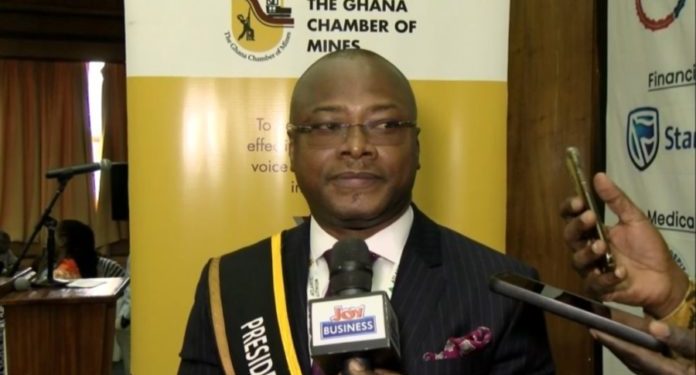Gold Lifts Ghana’s Economy, But Fiscal Frictions Threaten Future Gains
Ghana’s mining industry emerged as a linchpin of the country’s economic rebound in 2024, with the gold sub-sector posting explosive 19.1% growth, making Ghana the continent’s top gold producer. Yet, beneath the strong economic metrics outlined in the presidential address by Michael Edem Akafia at the Ghana Chamber of Mines’ 2025 AGM lies a warning: fiscal unpredictability, security lapses, and regulatory inefficiencies could compromise future growth and investor confidence.
Gold Surges, Mining Anchors GDP Growth
The data tells a compelling story. Mining and quarrying contributed 13.9% to Ghana’s GDP in 2024, up from 12.8%, making it the third-largest contributor to the economy after retail and agriculture. Overall, real GDP expanded by 5.7%, the highest since 2019.
Gold production soared to 149.8 tonnes, a 19.3% jump from 2023. Significantly, the small-scale sector’s contribution hit a historic high of 39.4%, with a 70.1% surge in attributable output. While large-scale producers stagnated, artisanal miners stepped into the gap, revealing a decentralised shift in production dynamics.
Fiscal Windfall but Structural Concerns
The mining sector paid GH₵17.7 billion in taxes, up 51.2% from 2023, accounting for nearly a quarter of all direct domestic taxes. Royalties alone grew by 76.7%, and dividends to the state soared by over 600%.
Yet, Akafia’s tone cautioned against complacency. “The 200% increase in the Growth and Sustainability Levy and its application on gross revenue threatens viability,” he noted, urging a review to preserve competitiveness. Other sticking points included VAT inefficiencies, permit backlogs, and fuel pricing distortions, which have strained operational cost structures.
Foreign Exchange Repatriation and Trade Balances
With US$11.9 billion in mineral exports, the mining sector accounted for 58.4% of total merchandise exports. Chamber members repatriated 70.8% of mineral earnings, a notable performance aiding reserve stability and cedi appreciation. Over US$906 million was surrendered to the Bank of Ghana, while an additional US$3.3 billion was repatriated through commercial banks—an impressive 22.2% year-on-year increase.
Production Forecasts and Uncertainties Ahead
The Chamber projects 2025 gold output between 4.4 and 5.1 million ounces, thanks to output from Newmont’s Ahafo South and Shandong’s Namdini Mine. However, structural output declines from Perseus, Gold Fields, and Zijin Mines may offset gains. A critical variable is the transformation of the PMMC into the Ghana Gold Board (GoldBod), which may alter pricing dynamics for small-scale miners.
Exploration Under Strain
Exploration budgets rose modestly in Ghana, from US$99.7 million to US$106.1 million, but the overall African allocation shrank. Akafia emphasised the strategic need to incentivise exploration, warning that reduced investment imperils the pipeline of future mines.
Cost Structure and Retained Earnings
Chamber members retained US$5.5 billion (73.7%) in-country. Of this, US$2.9 billion went to local procurement, US$1.4 billion to taxes, and over US$600 million to wages. Only US$28 million went to community development, an area critics may spotlight as underwhelming given the sector’s earnings.
However, the offshore leakage remains significant: nearly US$1 billion in capital expenditure and US$660 million in shareholder transfers signal that substantial portions of mineral revenue exit Ghana’s economy.
Regulatory Friction and Political Pressure Points
A litany of grievances marred the otherwise glowing fiscal and production report:
- Exploration permit delays, with applications dating back to 2009, have become emblematic of bureaucratic inertia.
- Illegal mining activities continue to undermine licensed operations, prompting calls for military protection.
- Dilapidated rail infrastructure, especially along the Western corridor, pushes miners to expensive road options.
- The controversial delay in ratifying Atlantic Lithium’s mining lease was cited as a stark example of regulatory lethargy.
Safety, Employment, and Social Metrics
The industry employed 11,372 people directly, with 99.4% being Ghanaians, supporting over 170,000 indirect jobs. Fatalities dropped from seven to three, but serious injuries spiked by 153%, prompting renewed safety initiatives.
Meanwhile, the Chamber’s Tertiary Education Fund funded 160 bursaries and 40 research projects, and the Ghana Mining Competency Framework was launched to standardise professional skills.
Conclusion: Gold Is Not Enough
Despite record-breaking revenues and an outsized contribution to GDP and exports, Ghana’s mining sector faces an inflection point. As President Akafia concluded, “To unlock our full potential, we need a fair and predictable fiscal regime, competitive operating costs, and robust infrastructure.” Without meaningful reforms and government responsiveness, the glittering promise of gold may be dulled by policy friction and missed opportunities.








